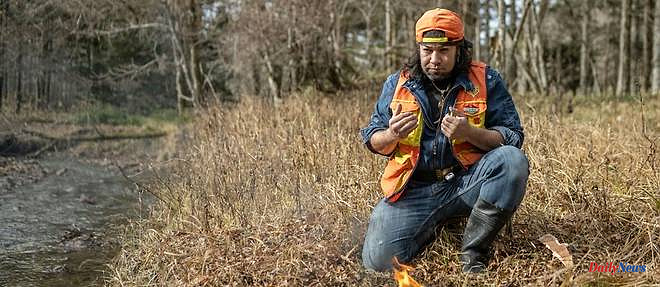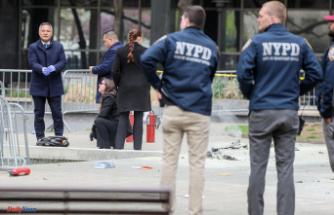In the heart of a forest on the northern Japanese island of Hokkaido, Atsushi Monbetsu kneels on the moss in the thick morning mist and says a prayer in the almost extinct language of the Ainu, one of the indigenous peoples of the Japanese archipelago.
"Kamui", he calls, addressing the Ainu deities. "An Ainu enters your forest and wants to hunt deer".
He quickly spots a small group of deer and shoots one with his gun, then, kneeling, places his hands in front of the animal, palms facing the sky, and waves them up and down to send his soul back "to the country. of the kamuis".
The Ainu traditionally lived in the islands now split between northern Japan and Russia, and traded with the Japanese, whom they called "Wajin".
But in 1869, the Empire of Japan annexed Ainu territories to Hokkaido and banned practices deemed "barbaric" like women's facial tattoos, forcing the Ainu to abandon traditional hunting and adopt Japanese names.
Tokyo only officially recognized them as indigenous people in 2019, after generations of forced integration policies that left deep scars: in Atsushi Monbetsu's childhood, the shame of his origins was so strong that his mother forbade him to use the word "Ainu".
"Even today, I sometimes hate my appearance, so clearly Ainu", slips Atsushi Monbetsu, now 40 years old and sporting the traditional full beard of this people.
Like a growing number of young descendants of Japan's indigenous communities, however, he has reclaimed his identity and some of the traditional practices he considers a "birthright".
According to Ainu animist beliefs, "kamui" inhabit every animal, tree, river, down to tools and fishing rods. "By living only with what we hunt in nature, we become humble, we feel that we owe our life to the kamui", says Atsushi Monbetsu.
Tomoya Okamoto also kept his origins silent for a long time, even to his friends, fearing ridicule. But over time, the 25-year-old changed his mind, in part thanks to the popularity of the manga "Golden Kamui", which depicts Ainu culture.
Convinced that the Ainu lifestyles in harmony with nature resonate with the environmental concerns of modern societies, he became a traditional craft sculptor, thus wanting to "protect the Ainu culture".
At least 13,000 Ainu live in Japan, according to the last census in Hokkaido, in 2017. A number probably underestimated, due to intermarriage and the reluctance of some to reveal their origins.
Thousands of kilometers away, in the Okinawa archipelago at the southern tip of Japan, it is even more difficult to count the population of Japan's other main indigenous people, whom the government does not officially recognize.
It is estimated, however, that most of Okinawan's 1.5 million people are of Ryukyu ancestry.
When the Kingdom of Ryukyu, a chain of islands now shared between the Japanese departments of Okinawa and Kagoshima, was formally annexed by Japan in 1879, the authorities also banned the local languages, with a process of forced assimilation even more implacable than in Hokkaido.
"Policies have been put in place to teach (the Ryukyu people) the Japanese language, demand their loyalty and ultimately make them fight" under the Japanese flag, explains Eiji Oguma, a sociologist from Keio University in Tokyo.
If in Hokkaido few people today speak the Ainu language fluently, in Okinawa elders are trying to transmit the different indigenous languages to the younger generations.
However, they are not taught in school, and descendants of the Ryukyu people, such as Okinawan rapper Ritto Maehara, struggle to speak them, despite the recent proliferation of books and YouTube videos aimed at teaching it.
"It makes me sad, because I can't speak and understand as much as I would like," the 38-year-old artist told AFP, whose fans ignite when he punctuates his texts describing life in the department. Japan's poorest of ryukyu words like "Yakke-yo!" ("That sucks!").
Ryukyu identity has been marked by the bloody history of World War II, when a quarter of the population perished in the name of the emperor during the Battle of Okinawa in 1945, including many civilians, massacred or forced to mass suicides.
But the post-war occupation of the islands by the United States and the still massive presence of American military bases in Okinawa changed the feeling of some of the inhabitants in favor of a return under Japanese control, effective since 1972. .
"Honestly, Okinawa has a lot of complex feelings," breathes Ritto Maehara. “It is only recently that I can say that I am proud to be Japanese”.
Many residents of the department have experienced similar identity crises, notes Hiroshi Komatsu, a researcher at the Center for Asia-Pacific Studies at Seikei University in Tokyo.
When these islands became a popular tourist destination with the Japanese in the 1990s, "many young Okinawans realized they didn't know what the real Okinawa was".
They then began to search for answers in various forms such as linguistics or traditional craftsmanship, he adds.
"Bingata", a local technique of stenciling traditional textile painting, was very popular with the nobility of the Ryukyu Islands with its shimmering colors and patterns inspired by the local fauna and flora, but almost disappeared after the annexation by Japan, the exile of the king of Ryukyu and the war.
At the Battle of Okinawa, "people lost everything but they still wanted to see the colors and the flowers of Okinawa", local craftsman Toma Chinen, heir to one of the three families who made bingata fabrics for the Ryukyu high society.
"They then recovered bed sheets or even parachute fabrics abandoned by the American army and dyed them", using quinine, a traditional anti-malaria drug, to obtain the characteristic yellow of bingata, says Mr. Chinen.
The 33-year-old carries on this age-old craft, adding his "paw" to refresh bingata's image and boost its appeal.
But while young Japanese descendants of the archipelago's indigenous peoples are increasingly comfortable with their identity and traditions, many believe the Japanese government is not supporting them enough.
The village where Atsushi Monbetsu lives in Hokkaido thus has subsidized cultural centers and museums, but several places considered sacred by the Ainu are not recognized, one of them even hosting industrial waste.
"It's so indelicate," he laments.
To perpetuate the Ainu cultural heritage, this father of three children works with the elders of the community to identify the rites and traditions, which he wishes to master and teach, "so that the younger generations can transmit them in turn".
17/02/2023 17:01:45 Biratori (Japanese) (AFP) © 2023 AFP












